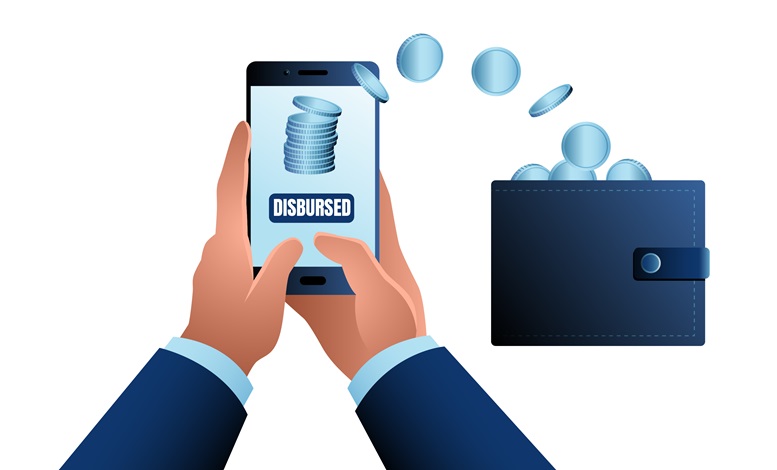

Did You Know?
We serve loans, the best way you can borrow

We serve loans, the best way you can borrow

If there’s a loan that offers seamless approval and speedy fund transfer, it’s none other than a personal loan, and if you are here to understand the loan disbursement steps, you are likely undergoing a crucial financial emergency.
Whether you need the loan for medical purposes, weddings, or travel plans, this post offers in-depth insight. Discover how you can proceed with the personal loan disbursement process effectively.
You can apply for a personal loan online or offline via a financial institute or bank. A personal loan disbursement occurs when the lender transfers the amount to the borrower's bank account.
Before initiating the loan disbursement process, the lender assesses various factors, including document verification and approval.
To understand the process of personal loan disbursement, you must understand the timeline between approval of the loan and disbursement. As a borrower, you need to review your application for loan disbursement.
Understanding how the loan disbursement process works is imperative for borrowers. That includes the steps involved in getting the fund disbursed from the lender. On that note, let's find out the steps in brief from the following points:
Submitting the loan application is the foundational step. A borrower needs to consider following the details mentioned in the application form (online or offline). You must type your full name, contact details, a valid address, and your job history. The following are the most important documents you need as proof for the approval of the loan application:
Soon after you submit the application attached with your documents, your lender verifies them. So, you must ensure that no information implemented in the application is untrue. Any inaccurate data in the application form may lead to rejection. The financial institute or lender will assess your creditworthiness depending on the documents you submit.
Also referred to as credit appraisal, it’s an important step in the loan disbursement process. The financial institute or bank evaluates your eligibility in this step. The bank or financial institute evaluates your repayment abilities. So, they will assess your CIBIL history.
Suppose someone with bad credit applies for a personal loan. During the loan disbursement process, the lender will then evaluate these things:
After assessing these parameters, the lender calculates the monthly EMI for your loan amount during the loan disbursement process. The lender also sets your loan disbursement process, amount, time, and interest rate. With credit appraisal, most financial institutes or banks tend to reduce risk.
Soon after the lender assesses the credit appraisal in the loan disbursement process, the lender then offers the loan. They give you a structure, mentioning details such as:
A loan offer is an agreement between the borrower and the lender. A borrower receives this agreement online or offline, depending on the type you select. It’s a borrower’s responsibility to carefully review loan offers, including the terms and conditions.
The borrower might sign and send the agreement back if they agree to the terms and conditions mentioned in it.
Now, coming to the ultimate step – the loan disbursement process. Here, your loan gets approved. You will receive the funds transacted to your designated bank account. After the lender disburses the loan, you will receive the amount in your bank account.
As long as the tenure does not end, a borrower must repay the loan in monthly EMIs, depending on the agreement. The amount will be disbursed after a sanction letter. This step usually takes around one to two working days. However, it may take more time depending on the lender’s procedure, (which varies from one financial institute or bank to another).
After the loan disbursement process, there are certain things a borrower needs to perform. First, the bank or financial institute sends a letter of confirmation to your email address as soon as the fund is transferred. You need to check the letter and might acknowledge it. You will be given information about your interest rate, principal outstanding for each month, etc.
Considering the repayment strategies, you must repay the loan in monthly EMIs before or on every month’s due date. The due date will be specified in your loan agreement. A borrower needs to keep in touch with the lender to learn about updates and the latest information, like payment options or changed due dates.
The payments will start after one month when the loan is disbursed. For example, suppose you get the loan before the 15th of the month. In such a circumstance, you need to start the payment schedule in the coming month.
So, the EMIs will be collected from the following month. Most borrowers these days select personal loan payments online. In that case, the amount gets easily deducted from your bank account on the due date or even before. Alternatively, you may select other payments such as cheque or ECS.
After getting your funds, you may start making payments from the next month onwards. You may repay your loan online (net banking or UPI) or offline (by visiting the bank or financial institute). Suppose you get a loan from a bank. In such circumstances, you may set up the auto-debit with your loan from the other bank. This bank might accept the repayment strategy via the salary account.
Note that the borrower should authorize the creditor to deduct the amount on a certain date during the loan disbursement process. Or you can give post-date cheques to your lender. So, your bank account should have enough money to cover this loan payment on or before the due date. Any failure to pay monthly EMIs may impact your credit score.
Financial issues rarely give warning signs before they hit your wallet. Before undergoing personal loan disbursement process, you should know that speedy help matters when bills stack up or emergencies strike without notice.
Your credit history directly affects how much time it takes to disburse personal loan funds. Better scores mean faster approvals and quicker money transfers.
Missing papers slow down your loan approval process. Complete files help lendingplate process your instant personal loan disbursal application faster.
Different banks process incoming transfers at various speeds. Your bank might hold funds for processing after lendingplate sends your money.
Larger loans may need extra approval steps. Smaller amounts often see faster instant personal loan disbursal times with fewer verification requirements.
Mistakes in your form cause delays every time. Double-check all details to ensure smooth processing of your instant personal loan disbursal.
Applications submitted late Friday might wait until Monday. Apply early on working days for the fastest instant personal loan disbursal experience.
When deciding on applying for a personal loan, you need to keep certain things in mind. Firstly, you must ensure decent finance that helps you manage the loan better. Note that personal loans are available with higher interest rates and expenses, unlike other types of loans.
Next, you should not hesitate to consult various lenders to get the best option. So, never undermine the importance of your loans:
A borrower must never opt for unnecessary spending. Also, you must keep in mind that applying for a certain loan amount is quite significant. So, one must make payments on time and protect their CIBIL score accordingly.
Getting a personal loan involves a few steps, like getting approved and then receiving the money. Once your loan application is approved and you sign the agreement, the lender will check your documents. Then, you'll need to choose the amount of money based on various parameters. Some of them include your CIBIL score, income evidence, and other proofs. After you receive the money, you might use it conveniently for your needs. The only thing you should remember is to pay the loan on time. That will ensure a good credit score. With the above things in mind, you can apply for a loan disbursement procedure seamlessly.
Most lendingplate loans reach your account within 30 minutes after approval. This instant personal loan disbursal speed beats traditional banks – which take 1-7 days. Your application completeness greatly affects this timeline. Missing documents or verification issues might cause small delays. lendingplate works hard to provide same-day funding whenever possible.
lendingplate transfers funds directly to your bank account for instant personal loan disbursal. This electronic transfer ensures your money arrives securely without handling physical cheques. You'll receive immediate notification when funds hit your account.
lendingplate primarily uses direct bank transfers for safety and speed. This standardised instant personal loan disbursal method protects both parties from payment problems. Your loan agreement specifies the account where funds will be sent. You can update your bank details before final approval if needed.
lendingplate charges processing fees between 1-5% of your loan amount, not separate disbursement fees. This fee covers all instant personal loan disbursal services and application processing costs. The exact percentage appears clearly in your loan offer document. Unlike some lenders, lendingplate doesn't add hidden charges after approval. All costs are transparent and explained before you sign anything.
You can request changes to your instant personal loan disbursal bank account before money transfers begin. Contact lendingplate customer service immediately if you need this change. They'll require verification to protect your account security. The process might add a short delay to your personal loan disbursement time after approval. Submit your new banking details through the secure lendingplate app for the fastest processing.
Wondering how to cancel personal loan after disbursement? Well, lendingplate allows cancellation within 14 days of receiving funds without major penalties. You must return the full loan amount plus applicable interest for the days used. The 5% foreclosure fee is waived if you repay after your first due date. Consult customer service immediately in case you need to cancel.
Download our personal loan app to apply for a personal loan. Get up to 2Lakhs* as a personal loan. Download Now!
Sign into avail a personal loan up to ₹ 2,50,000
Register to avail an instant loan in just a few minutes. Fulfil your financial needs with our loan and repay in easy EMIs.
Apply NowUnifinz Capital India Limited is a Non Banking Finance Company (NBFC) registered with the Reserve Bank of India (RBI). lendingplate is the brand name under which the company conducts its lending operations and specialises in meeting customer’s instant financial needs.
Corporate Identity No. (CIN)
L 1 7 1 1 1 D L 1 9 8 2 P L C 0 1 3 7 9 0
RBI Certificate of Registration No (CoR):
1 4 . 0 0 2 3 3
Registered Office :
Rajlok Building (Floor-5), 24 Nehru Place, New Delhi-110 019